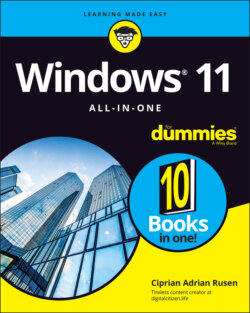Читать книгу Windows 11 All-in-One For Dummies - Ciprian Adrian Rusen - Страница 25
Connecting your PC to other devices
ОглавлениеYour PC connects to the outside world by using a bewildering variety of cables and connectors. I describe the most common in this list:
USB (Universal Serial Bus) cable: This cable has a flat connector (known as USB A) that plugs into your PC, as shown in Figure 1-11. The other end is sometimes shaped like a D (called USB B), but smaller devices have tiny terminators (usually called USB mini and USB micro, each of which can have two different shapes). USB 2 connectors work with any device, but hardware — such as a hard drive — that uses USB 3 will be much faster if you use a USB 3 cable and plug it into the back of your computer in a USB 3 port. USB 2 works with USB 3 devices, but you won’t get the additional speed. Note that not all PCs have USB 3 ports, especially older PCs.Source: WikimediaFIGURE 1-11: The most common USB A, B, C, Mini, and Micro USB cables.USB-C is a special kind of USB connection that supports amazingly fast data transmission and high levels of power. You know when you have USB-C because it’s impossible to insert the plug upside down — both sides work equally well. It’s becoming the go-to choice for connecting peripherals and, in some cases, power supplies. USB is the connector of choice for just about any kind of hardware — printer, scanner, smartphone, digital camera, portable hard drive, and even the mouse. Apple’s iPhones and iPads use a USB connector on one end — to plug in to your computers — but the other end is Lightning (common on Apple devices, not so common on Windows PCs) and doesn’t look or act like any other connector.If you run out of USB connections on the back of your PC, get a USB hub with a separate power supply and plug away.
LAN cable: Also known as a CAT-5, CAT-6, or RJ-45 cable, it’s the most common kind of network connector. It looks like an overweight telephone plug (see Figure 1-12). One end plugs in to your PC, typically into a network interface card (or NIC, pronounced “nick”) or a network connector on the motherboard. The other end plugs in to your wireless router (see Figure 1-13) or switch or into a cable modem, DSL box, router, or other internet connection-sharing device.Source: David Monniaux, WikimediaFIGURE 1-12: RJ-45 Ethernet LAN connector.FIGURE 1-13: The back of a wireless router.
Keyboard and mouse cable: Most mice and keyboards (even cordless mice and keyboards) come with USB connectors.
Bluetooth is a short-distance wireless connection. Once upon a time, Bluetooth was finicky and hard to set up. In recent years, it has become quite useful and is now used to connect all kinds of accessories: speakers, headsets, mice, and keyboards.
DisplayPort and HDMI connectors: Modern computer monitors and smart TVs use small HDMI (see Figure 1-14), DisplayPort (see Figure 1-15) or mini DisplayPort connectors, which transmit both audio and video over one cable.
Source: Amazon
FIGURE 1-14: HDMI replaces the old VGA and DVI-D video adapters.
Source: Wikimedia
FIGURE 1-15: DisplayPort is a modern alternative to HDMI.
